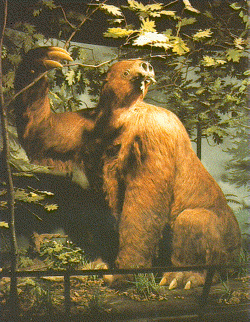
November 7, 2010

Jefferson’s Ground Sloth (above right) is an extremely important fossil animal in American history, having been first discovered by Thomas Jefferson (above left). The species was the subject of the first and second scientific articles on fossils ever published in the United States. The generic name Megalonyx was proposed by future U.S. President Thomas Jefferson in 1797, based on fossil specimens of what later came to be called Megalonyx jeffersonii that he had received from western Virginia. His presentation to the American Philosophical Society that year is often credited as the beginning of vertebrate paleontology in North America.

Reconstruction based on Megalonyx jeffersonii, Iowa Museum of Natural History, University of Iowa.
Now breaking news is forthcoming that a remarkable find has occurred in Colorado.
Paleontologists excavating a Pleistocene ecosystem in the resort town of Snowmass Village, Colorado, say they have found the first Jefferson’s ground sloth ( Megalonyx jeffersonii) ever discovered in Colorado. Megalonynx jeffersonii fossils have been found from Virginia to as far north as Alaska. Recently, this species’ fossils have been found in southwest Iowa (in the now famous Tarkio Valley site), in close association with Paramylodon harlani.

Map (2006) showing locations where remains of Megalonyx jeffersonii have been recovered from Wisconsinan sites (Source).
Denver Museum of Nature & Science research associate Greg McDonald confirmed over the weekend that a bone found earlier last week is the upper arm of the Jefferson’s ground sloth.

McDonald says that other sloths have been found in Colorado, but they were a different species called Harlan’s ground sloth (Paramylodon harlani, shown above and below). The bone found this week is the first from a Jefferson’s ground sloth in Colorado.

So far, scientists working at the site also have found a Columbian mammoth, American mastodon, Pleistocene bison and an Ice Age deer.
Cryptozoologists (especially, thanks to the work of Dr. David Oren) identify the Mapinguary, a rainforest cryptid of the upper Amazon basin, as a possible surviving tropical ground sloth (generally aligned to Megatherium, shown below) or folk memory of these animals.


One does wonder if Matt Bille might look out his Colorado window one day and not see an Ice Age bear bone sticking out of his backyard, but, instead, Megalonyx fossil coming to visit.
About Loren Coleman
Loren Coleman is one of the world’s leading cryptozoologists, some say “the” leading living cryptozoologist. Certainly, he is acknowledged as the current living American researcher and writer who has most popularized cryptozoology in the late 20th and early 21st centuries.
Starting his fieldwork and investigations in 1960, after traveling and trekking extensively in pursuit of cryptozoological mysteries, Coleman began writing to share his experiences in 1969. An honorary member of Ivan T. Sanderson’s Society for the Investigation of the Unexplained in the 1970s, Coleman has been bestowed with similar honorary memberships of the North Idaho College Cryptozoology Club in 1983, and in subsequent years, that of the British Columbia Scientific Cryptozoology Club, CryptoSafari International, and other international organizations. He was also a Life Member and Benefactor of the International Society of Cryptozoology (now-defunct).
Loren Coleman’s daily blog, as a member of the Cryptomundo Team, served as an ongoing avenue of communication for the ever-growing body of cryptozoo news from 2005 through 2013. He returned as an infrequent contributor beginning Halloween week of 2015.
Coleman is the founder in 2003, and current director of the International Cryptozoology Museum in Portland, Maine.
Filed under Breaking News, CryptoZoo News, Extinct, Fossil Finds, Mapinguary, Megafauna, Replica Cryptia